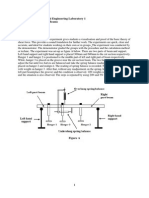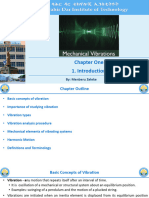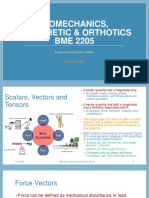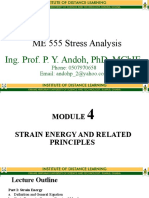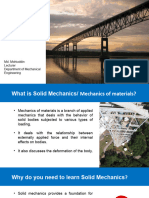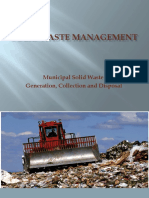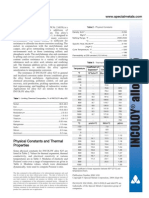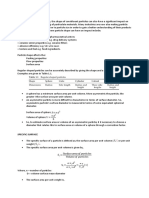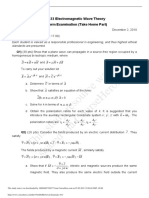0 ratings0% found this document useful (0 votes)
49 viewsL6 Deflection and Stiffness
This document discusses deflection and stiffness concepts including:
1) Bodies can deform elastically or plastically under load and deflection analysis is important for design.
2) Spring rate is defined as the ratio of applied force to deflection and most problems involve linear relationships.
3) Beam deflection can be analyzed using methods like superposition, moment-area, and numerical integration.
4) Strain energy represents the energy stored due to deformation and Castigliano's theorem relates displacements to partial derivatives of strain energy.
Uploaded by
Babila JosephCopyright
© © All Rights Reserved
Available Formats
Download as PPTX, PDF, TXT or read online on Scribd
0 ratings0% found this document useful (0 votes)
49 viewsL6 Deflection and Stiffness
This document discusses deflection and stiffness concepts including:
1) Bodies can deform elastically or plastically under load and deflection analysis is important for design.
2) Spring rate is defined as the ratio of applied force to deflection and most problems involve linear relationships.
3) Beam deflection can be analyzed using methods like superposition, moment-area, and numerical integration.
4) Strain energy represents the energy stored due to deformation and Castigliano's theorem relates displacements to partial derivatives of strain energy.
Uploaded by
Babila JosephCopyright
© © All Rights Reserved
Available Formats
Download as PPTX, PDF, TXT or read online on Scribd
You are on page 1/ 21
Deflection and Stiffness
MEC 4205 Special Topics
Introduction
• All real bodies deform under load, either elastically or plastically. A
body can be sufficiently insensitive to deformation that a presumption
of rigidity does not affect an analysis enough to warrant a non-rigid
treatment.
• If the body deformation later proves to be not negligible, then
declaring rigidity was a poor decision, not a poor assumption.
• A wire rope is flexible, but in tension it can be robustly rigid and it
distorts enormously under attempts at compressive loading.
• The same body can be both rigid and non-rigid.
• Deflection analysis enters into design situations in many ways. A snap
ring, or retaining ring, must be flexible enough to be bent without
permanent deformation and assembled with other parts, and then it
must be rigid enough to hold the assembled parts together.
• In a transmission, the gears must be supported by a rigid shaft. If the
shaft bends too much, that is, if it is too flexible, the teeth will not
mesh properly, and the result will be excessive impact, noise, wear,
and early failure.
• In rolling sheet or strip steel to prescribed thicknesses, the rolls must be
crowned, that is, curved, so that the finished product will be of uniform
thickness. Thus, to design the rolls it is necessary to know exactly how
much they will bend when a sheet of steel is rolled between them.
• Sometimes mechanical elements must be designed to have a particular
force-deflection characteristic.
• The suspension system of an automobile, for example, must be
designed within a very narrow range to achieve an optimum vibration
frequency for all conditions of vehicle loading, because the human body
is comfortable only within a limited range of frequencies.
Spring Rates
• Elasticity is that property of a
material that enables it to regain
its original configuration after
having been deformed.
• A spring is a mechanical
element that exerts a force
when deformed. (a) A linear spring; (b) a stiffening spring;
(c) a softening spring.
Force Deflection Relationships
• If we designate the general relationship between force and deflection
by the equation
• then spring rate is defined as
• where y must be measured in the direction of F and at the point of
application of F.
• Most of the force-deflection problems we shall encounter are linear.
For these, k is a constant, also called the spring constant;
consequently above equation is written
Tension, Compression, and Torsion
• The total extension or contraction of a uniform bar in pure tension or
compression, respectively, is given by
• This equation does not apply to a long bar loaded in compression if
there is a possibility of buckling
• Using preceding equations with , we see that the spring constant of
an axially loaded bar is
• The angular deflection of a uniform solid or hollow round bar
subjected to a twisting moment T was given by where u is in radians.
• We can convert the above equation to degrees by multiplying by and
substituting for a solid round bar giving
• Rearranging the previous equation gives , the torsional spring rate
• These equations apply only to circular cross sections.
Deflection Due to Bending
• The
curvature of a beam subjected to a bending moment M is given by
•
• where is the radius of curvature. From studies in mathematics we also learn
that the curvature of a plane curve is given by the equation
• where the interpretation here is that y is the lateral deflection of the
centroidal axis of the beam at any point x along its length. The slope of the
beam at any point x is
• The previous Equation can then be written as
• It is convenient to display these relations in a group as follows:
Beam Deflection Methods
• The
preceding Equations are the basis for relating the intensity of loading q ,
vertical shear V , bending moment M , slope of the neutral surface u , and
the transverse deflection y . Beams have intensities of loading that range
from (uniform loading), variable intensity q ( x ), to Dirac delta functions
(concentrated loads).
• All of the above constitute, in one form or another, formal integration
methods, which, with properly selected problems, result in solutions for q, V,
M, u, and y. These solutions may be
• Closed-form, or
• Represented by infinite series, which amount to closed form if the series are rapidly
convergent, or
• Approximations obtained by evaluating the first or the first and second terms.
Solution Methods
• There are many techniques employed to solve the integration
problem for beam deflection. Some of the popular methods include:
• Superposition
• The moment-area method
• Singularity functions
• Numerical integration
Beam Deflections by Superposition
• Superposition resolves the effect of combined loading on a structure
by determining the effects of each load separately and adding the
results algebraically. Superposition may be applied provided:
1) each effect is linearly related to the load that produces it,
2) a load does not create a condition that affects the result of another
load, and
3) the deformations resulting from any specific load are not large
enough to appreciably alter the geometric relations of the parts of
the structural system.
Shear, Moment, and Deflection of Beams
Beam Deflections by Singularity Functions
Strain Energy
• The external work done on an elastic member in deforming it is
transformed into strain, or potential, energy . If the member is
deformed a distance y, and if the force-deflection relationship is
linear, this energy is equal to the product of the average force and the
deflection, or
• This equation is general in the sense that the force F can also mean
torque, or moment, provided, of course, that consistent units are
used for k. By substituting appropriate expressions for k, strain-
energy formulas for various simple loadings may be obtained.
Strain Energy Examples
Strain Energy due to direct shear
Castigliano’s Theorem
• Castigliano’s theorem states that when forces act on elastic systems
subject to small displacements, the displacement corresponding to
any force, in the direction of the force, is equal to the partial
derivative of the total strain energy with respect to that force.
• The terms force and displacement in this statement are broadly
interpreted to apply equally to moments and angular displacements.
Mathematically, the theorem of Castigliano is
• Where is the displacement of the point of application of the force Fi
in the direction of Fi.
Castigliano’s Theorem
• For rotational displacement
• where is the rotational displacement, in radians, of the beam where
the moment Mi exists and in the direction of Mi
• The axial and torsional deflections.
You might also like
- Hourglass Workout Program by Luisagiuliet 276% (21)Hourglass Workout Program by Luisagiuliet 251 pages
- The Hold Me Tight Workbook - Dr. Sue Johnson100% (16)The Hold Me Tight Workbook - Dr. Sue Johnson187 pages
- Livingood, Blake - Livingood Daily Your 21-Day Guide To Experience Real Health77% (13)Livingood, Blake - Livingood Daily Your 21-Day Guide To Experience Real Health260 pages
- Shortcut To Shred Ebook Revised 9-9-2015 PDF88% (8)Shortcut To Shred Ebook Revised 9-9-2015 PDF15 pages
- The 36 Questions That Lead To Love - The New York Times94% (34)The 36 Questions That Lead To Love - The New York Times3 pages
- The 36 Questions That Lead To Love - The New York Times95% (21)The 36 Questions That Lead To Love - The New York Times3 pages
- Jeffrey Epstein39s Little Black Book Unredacted PDF75% (12)Jeffrey Epstein39s Little Black Book Unredacted PDF95 pages
- 14 Easiest & Hardest Muscles To Build (Ranked With Solutions)100% (7)14 Easiest & Hardest Muscles To Build (Ranked With Solutions)27 pages
- The 4 Hour Workweek, Expanded and Updated by Timothy Ferriss - Excerpt23% (954)The 4 Hour Workweek, Expanded and Updated by Timothy Ferriss - Excerpt38 pages
- Chapter Five[Internal actions in beams]No ratings yetChapter Five[Internal actions in beams]21 pages
- Bending 6.3-6.4: Longitudinal Strain Flexure FormulaNo ratings yetBending 6.3-6.4: Longitudinal Strain Flexure Formula33 pages
- Chapter 1 - Shear Forces and Bending MomentsNo ratings yetChapter 1 - Shear Forces and Bending Moments27 pages
- Ce5101 Structural Analysis-Ii BY S K Singh: Lecture No 3No ratings yetCe5101 Structural Analysis-Ii BY S K Singh: Lecture No 325 pages
- Types of Loading: Point Loading Uniformly Distributed Loading (UDL) Varying Distributed Loading (VDL)No ratings yetTypes of Loading: Point Loading Uniformly Distributed Loading (UDL) Varying Distributed Loading (VDL)33 pages
- Ministry of Education Yangon Technological University Department of Civil EngineeringNo ratings yetMinistry of Education Yangon Technological University Department of Civil Engineering72 pages
- BME 2205 Lecture 2 Review of Engineering MechnicsNo ratings yetBME 2205 Lecture 2 Review of Engineering Mechnics21 pages
- Assignment NO.6 Rao Arslan: MCVS-021R20P-2No ratings yetAssignment NO.6 Rao Arslan: MCVS-021R20P-29 pages
- Stress and Strain: Solid Mechanics 1 MECH 0004No ratings yetStress and Strain: Solid Mechanics 1 MECH 000430 pages
- MG University - Barch - Semester Three - Structure DesignNo ratings yetMG University - Barch - Semester Three - Structure Design28 pages
- Steel Structure Lec # 08 (Introduction to compressive members)No ratings yetSteel Structure Lec # 08 (Introduction to compressive members)38 pages
- Unit-I Thin Plate Theory, Structural InstabilityNo ratings yetUnit-I Thin Plate Theory, Structural Instability78 pages
- Shear and Moment Equations and DiagramsNo ratings yetShear and Moment Equations and Diagrams69 pages
- Mechanical Vibrations Experiment Leaf PDFNo ratings yetMechanical Vibrations Experiment Leaf PDF9 pages
- A Feasibility Study Business Plan On RoaNo ratings yetA Feasibility Study Business Plan On Roa29 pages
- NorthStateIntercityBusSystemBusinessPlan Approved20180619 Adminedit20180808 201808081132180072No ratings yetNorthStateIntercityBusSystemBusinessPlan Approved20180619 Adminedit20180808 201808081132180072230 pages
- Quantum Tunneling Composites and Detectors For Intelligent Transportation SystemsNo ratings yetQuantum Tunneling Composites and Detectors For Intelligent Transportation Systems5 pages
- Gerardo Cifuentes (1), Jaime Simpson (1), Francisco Lobos (1), Leoncio Briones (2) and Alejandro MoralesNo ratings yetGerardo Cifuentes (1), Jaime Simpson (1), Francisco Lobos (1), Leoncio Briones (2) and Alejandro Morales5 pages
- Paticle Shape, Specific Surface, SphericityNo ratings yetPaticle Shape, Specific Surface, Sphericity2 pages
- Practice Problems: Unit 3G Circular MotionNo ratings yetPractice Problems: Unit 3G Circular Motion5 pages
- This Study Resource Was: EE523 Electromagnetic Wave Theory Midterm Examination (Take Home Part)No ratings yetThis Study Resource Was: EE523 Electromagnetic Wave Theory Midterm Examination (Take Home Part)2 pages







































